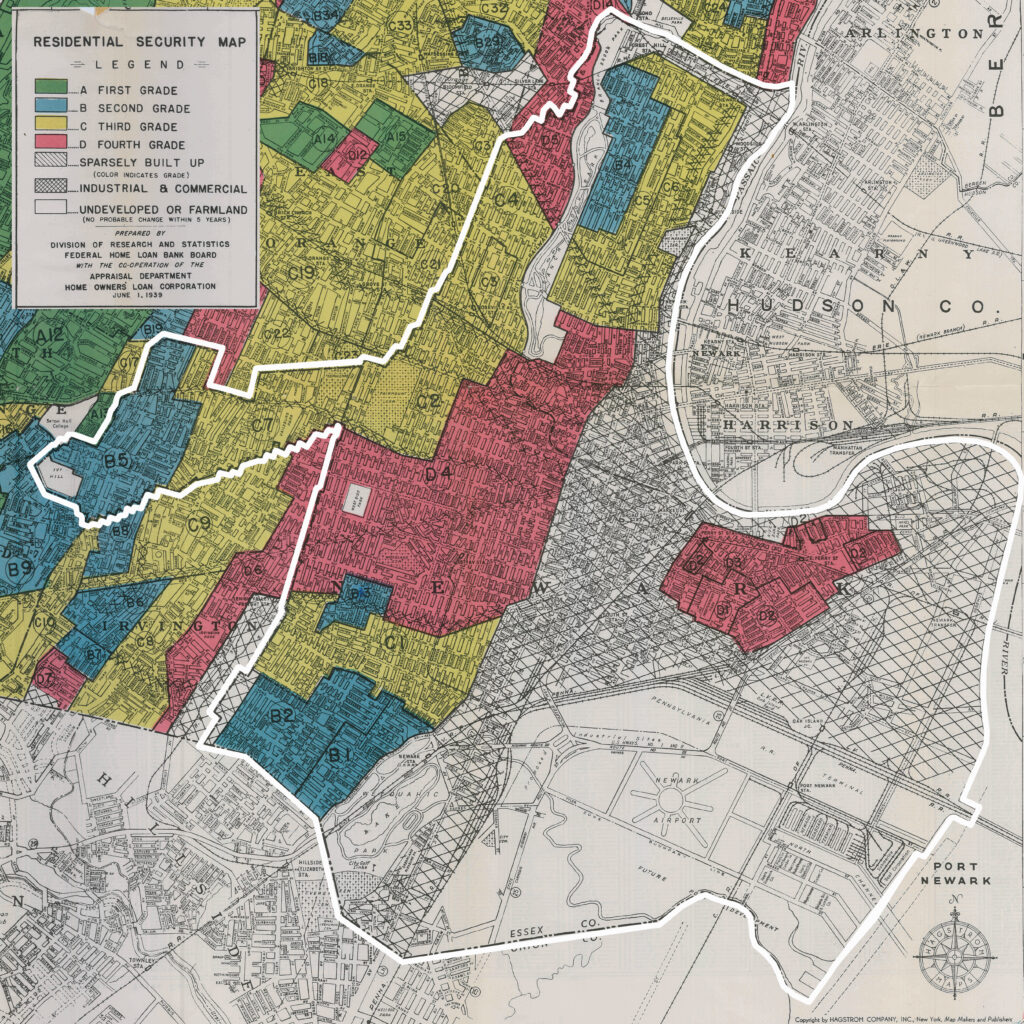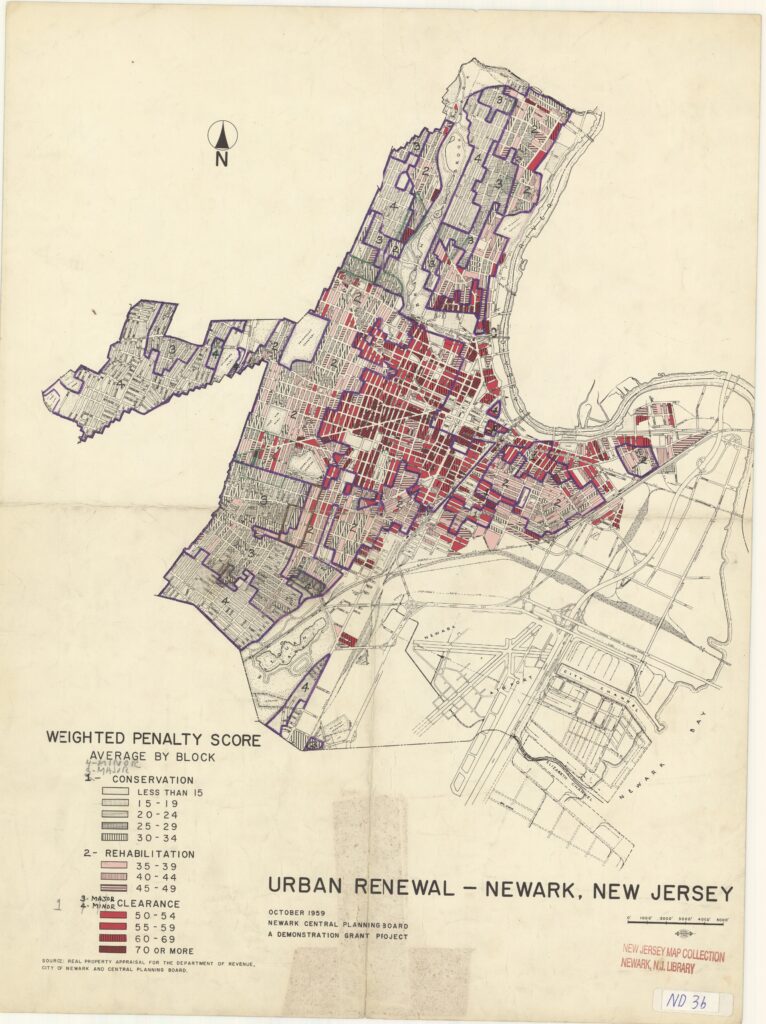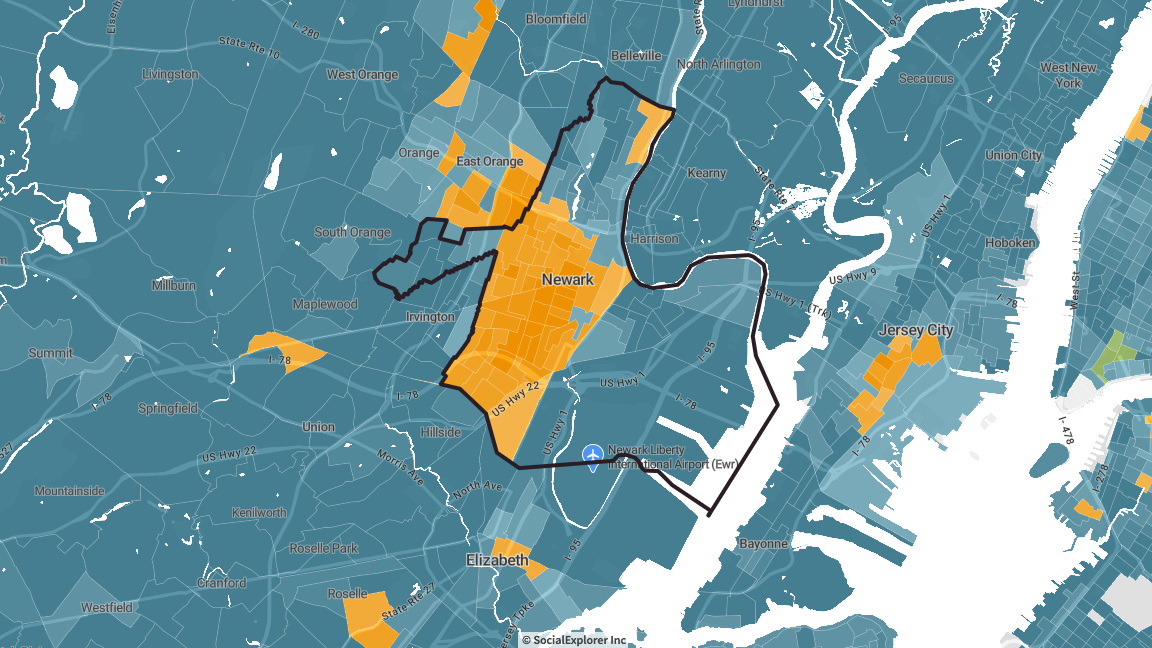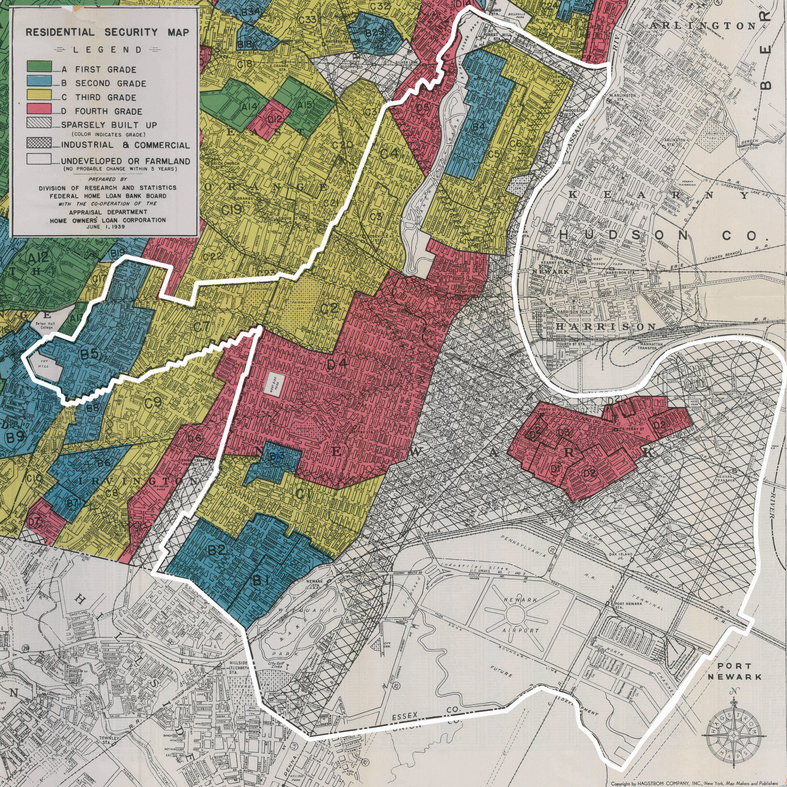Three visuals explain a century of urban history.
.
When most people see so-called ghetto and slum neighborhoods, they think these places are states of exception, places where the rule of law does not exist. The state and private investors seem to have abandoned the neighborhood to the urban poor. Another way of seeing this is that empty lots, abandoned buildings, parking lots, and concentrations of poverty in the urban core represent not the failure of government policy but its success. The urban decay of 20th-century cities like Newark and Detroit was the product of pro-suburban and pro-auto policies from corporations, developers, banks, and the state. These institutions all collaborated to funnel wealth away from Black peoples, homes, businesses, and Blacks’ desires for the middle class American Dream.
1. Demographic Change
.
Dr. Berg’s photos show the city on the edge of urban renewal. The collection documents neighborhoods in the process of White flight, and the replacement of wealthier White residents with poorer Black residents from the American South. And yet, Black Newarkers created communities and institutions for themselves in the face of state policy that excluded them from participation in majority-White institutions. Blacks created mutual self-help groups in Baptist churches, Black nationalist groups like Nation of Islam, Black schools like State Street School, Black-owned newspapers like Advance, and Black hospitals like Kenney Memorial. These photos illustrate the neighborhoods Blacks lived in and the businesses Blacks built and owned before the state seized and demolished them. The oldest photos in this collection from 1959 show mixed-race Italian, Jewish, and Black neighborhoods with over 90% home occupancy, few vacant lots, and no abandoned buildings. Later photos up to 1968 show urban renewal in progress: the demolition of hundreds of brownstones for the campuses of Rutgers and NJIT, even larger-scale demolition for UMDNJ, and block after block emptied out by Whites, Jews, and ethnic Whites who had fled to the suburbs on Interstates 280 and 78 sliced through the urban form.
2. Redlining
.
To be demolished, a neighborhood must first be declared blighted. To be declared blighted, decay must be documented and, if need be, created. Redlining is the process of withholding services, in particular mortgages, from people who live in neighborhoods classified as “hazardous’ to investment.” In 1930s redlining maps, every neighborhood with any number of Blacks, ethnic Whites, or populations of Blacks and Whites living together was color-coded “red” for hazardous, hence the term redlining. On the basis of these maps, banks denied home mortgages to Black residents in their neighborhoods while opening up investment opportunities to White residents in their own neighborhoods. Or, even without viewing these maps, the general public and bank employees knew where non-White peoples lived, often in some of the oldest housing stock with the fewest modern amenities. In this way, without even viewing redlining maps, biased officials could act in ways that further segregated neighborhoods.

1939 redlining map of Newark (source)
Each neighborhood on hundreds of redlining maps for every major American city and town was given a color code: green for “best,” blue for “still desirable,” yellow for “definitely declining,” and red for “hazardous.” Accompanying each neighborhood was also a datasheet summarizing its living conditions and reasons for the low or high grade. Not one neighborhood in Newark was colored green as the safest and best investment. At the same time, the majority of Newark’s Central Ward and much of its West Ward were colored in a single shade of red. The residences of at least 100,000 non-White people, and the reason for withholding investment in their neighborhoods, was reduced to a one-paragraph justification:
This is Newark’s worst slum section and embraces a large area adjacent to the downtown business district. A few small portions were good residential many years ago. About 45% of the structures are tenements and low-grade flats. Considerable demolition and boarding-up has taken place. Institutional holdings are heavy and ultimate disposition is a problem. Sales have been made, some to negroes, some with the help of B/L shares at discounts. It is an area of minimum values and useful only to those in lowest income brackets who need to be in walking distance of work. A slum clearance … is under way … others are proposed.
The blight predicted by redlining became a self-fulfilling prophecy. Denying investment to these neighborhoods’ residents because they were “blighted,” in turn, made many of these neighborhoods, in fact, blighted. Urban decay is never a product of poor residents’ lack of work ethic and care for their community but rather a product of segregation laws and political systems. The developers of the 1950s New Jersey suburb of Levittown, for instance, justified constructing suburban houses for Whites only on these terms: “We can solve a housing problem, or we can try to solve a racial problem, but we cannot combine the two.” Redlining and suburbs benefited Whites with good homes in safe neighborhoods. Blacks and non-White peoples were left behind. The consequences of refusing to solve the racial problem in the 1950s persist in the divided America of the 2020s. Newark and New Jersey remain among the most racially segregated regions in America.
3. Blight
.

1959 blight map of Newark (source)
This map shows the areas deemed blighted in 1959. Note that all blighted areas correspond to all redlined areas, and all redlined areas correspond to Black, Italian, and Hispanic neighborhoods. Newark’s urban core might not have been economically challenged in the 1930s, but it had become challenged by the 1950s through a mixture of state and corporate actions. This map was produced as the first step in advance of urban renewal and eminent domain. Almost every building on every block on this map colored red has been demolished, either through some combination of direct state-funded demolition or indirect refusal to invest in these neighborhoods, which condemned these buildings to abandonment and later demolition.

Map of Black neighborhoods in 1970. Note in this map that all neighborhoods demolished because they were declared slums correspond to all redlined neighborhoods, and all redlined neighborhoods correspond to Black neighborhoods. Black codes for blight, and blight codes for slum clearance.
As you view these photos of old Newark homes and businesses, consider: To what degree were these neighborhoods actually slums and blighted? Based on the study of history, and of the failure of past (and many present) urban renewal projects, how can Newark leaders and Newark developers work toward a truly just, inclusive, and egalitarian metropolis?
“Cities have the capability of providing something for everybody only because, and only when, they are created by everybody.”
– Jane Jacobs, The Death and Life of Great American Cities, 1961
“I think that the past is all that makes the present coherent, and further, that the past will remain horrible for exactly as long as we refuse to assess it honestly.”
– James Baldwin, Notes of a Native Son, 1955


